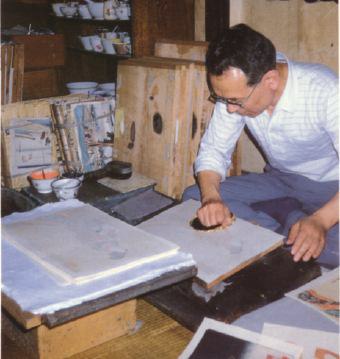The Printing Bench
Unlike the carving bench, which slopes slightly towards the worker, the traditional printing bench slopes in the opposite direction, away from one's body.
 This allows the arm and hand to move across the woodblock
in a natural curve, using the shoulder as a pivot point. Rather than
the force coming from the hand or lower arm, the power seems to come
up from the body and down through the entire length of the
arm.
This allows the arm and hand to move across the woodblock
in a natural curve, using the shoulder as a pivot point. Rather than
the force coming from the hand or lower arm, the power seems to come
up from the body and down through the entire length of the
arm.
If the bench is too high, as mine is in this photograph, this power is weakened, just as it is if the angle is too 'flat', as mine is in this photograph!
The dimensions of a typical Japanese printer's bench are: about 15cm high at the front, about 9cm high at the back, and an angle of between 8 and 10 degrees from the horizontal. But for those of you (like me) who are considerably taller than most of those craftsmen (considerably!), and who did not grow up sitting on the floor, this size would almost certainly be too low to manage without running into back trouble (and that's of course why mine is 'too high'. I really can't manage one much lower than this.)
The traditional printer's bench is also open at the back (mine in the photograph is actually half of a traveling case ...). Again, unlike the carver's bench, which is a carefully crafted piece of heavy-duty furniture, it is really nothing more than a stiff board slapped onto two end pieces chopped at an angle. Here's a picture of a real one!

This is Mr. Ritsuzo Sato at work. Look at the position of his left leg and foot - and then look at mine in the photograph above ... You can see why he gets such smooth and deep colour!
Another interesting point to note is the small bit of rag at the corner of the woodblock. The wood is 'standing' on four of these slightly dampened rags, which both stop it from moving, and elevate it slightly. If a larger damp cloth extending under the entire block were to be used, there would be two problems: the block may start warping from the moisture, and more importantly, it would lose the springy feeling it gets from being held up at the corners like this. This is a very important point - without that 'spring', the work is much more unresponsive and tiresome.
